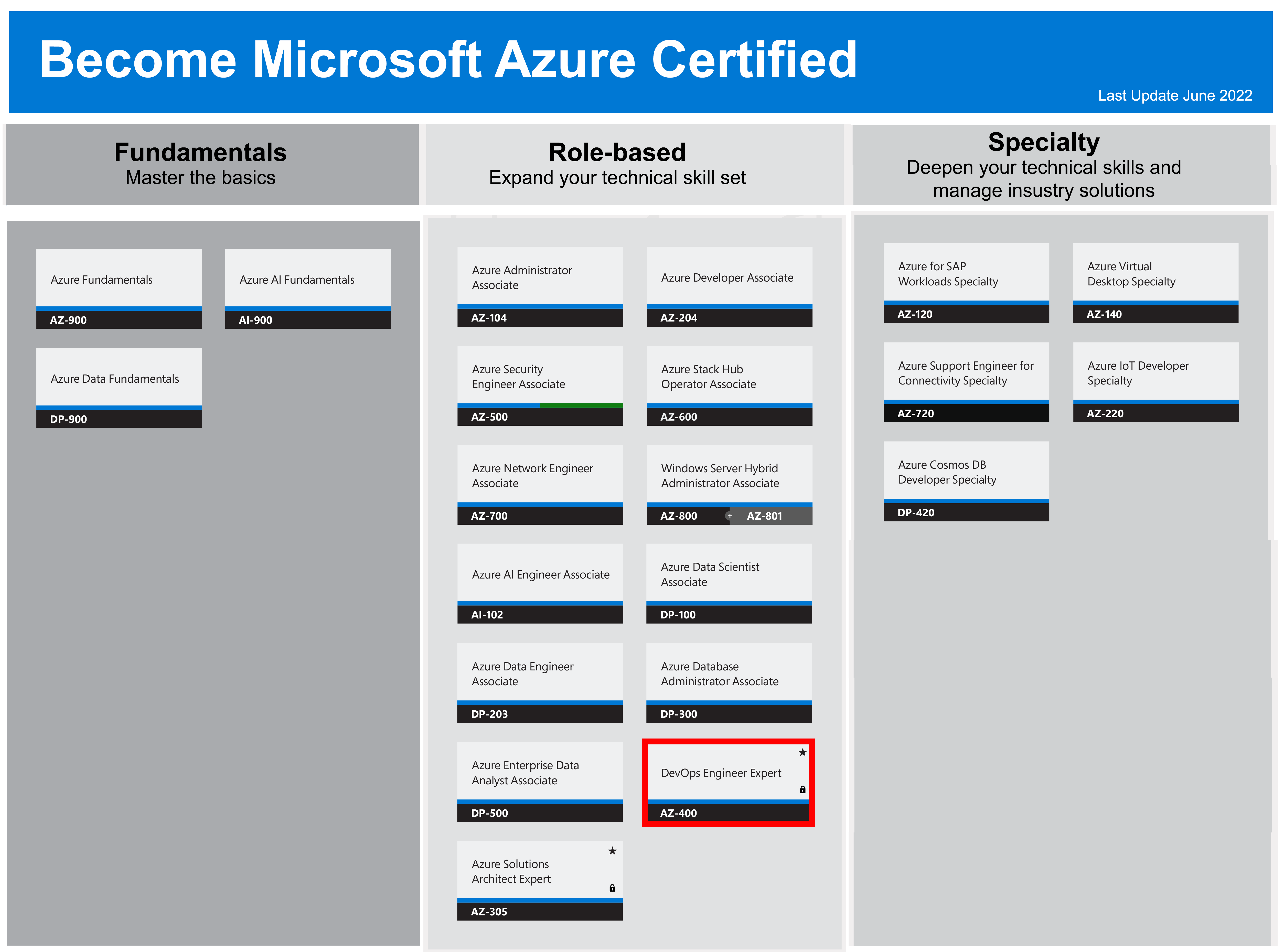AZ-400 - Designing and Implementing Microsoft DevOps Solutions
Microsoft cours officiels
Home » ISEIG Cours » AZ-400 – Designing and Implementing Microsoft DevOps Solutions
Ce cours est dispensé en français sur la base d'une documentation pédagogique en anglais.
This course provides the knowledge and skills to design and implement DevOps processes and practices. Students will learn how to plan for DevOps, use source control, scale Git for an enterprise, consolidate artifacts, design a dependency management strategy, manage secrets, implement continuous integration, implement a container build strategy, design a release strategy, set up a release management workflow, implement a deployment pattern, and optimize feedback mechanisms.
These courses help prepare for the exams « Microsoft Certified: Azure Administrator Associate (AZ-400) ».
This course provides the knowledge and skills to design and implement DevOps processes and practices. Students will learn how to plan for DevOps, use source control, scale Git for an enterprise, consolidate artifacts, design a dependency management strategy, manage secrets, implement continuous integration, implement a container build strategy, design a release strategy, set up a release management workflow, implement a deployment pattern, and optimize feedback mechanisms.
These courses help prepare for the exams « Microsoft Certified: Azure Administrator Associate (AZ-400) ».

Modules et dates
This course of 5 days is given once a semester, 1 to 2 days a week, from 9:00 am to 12:00 pm and from 1:30 pm to 5:00 pm.
AZ-400 - Designing and Implementing Microsoft DevOps Solutions
Durée
5
Prix
CHF 3'750.-
Prix/j.
CHF 750.-
Cycle 1
on demand
The course is given in French on the basis of documentation in French if available (Fra) or in English (Eng). If it is available in both languages, the French version is distributed unless specifically requested by the interested party. The price of the course includes all the pedagogical documentation distributed.
AZ-400 - Designing and Implementing Microsoft DevOps Solutions
Overview
This 5-day course is designed for IT Professionals. In this course, the student will learn how to:
- plan for the transformation with shared goals and timelines
- select a project and identify project metrics and KPIs
- create a team and agile organization structure
- describe the benefits of using Source Control
- migrate from TFVC to Git
- scale Git for Enterprise DevOps
- recommend artifact management tools and practices
- abstract common packages to enable sharing and reuse
- migrate and consolidate artifacts
- migrate and integrate source control measures
- manage application config and secrets
- develop a project quality strategy
- plan for secure development practices and compliance rules
- implement and manage build infrastructure
- explain why continuous integration matters
- implement continuous integration using Azure DevOps
- manage code quality including: technical debt, SonarCloud, and other tooling solutions
- manage security policies with open source, OWASP, and WhiteSource Bolt
- implement a container strategy including how containers are different from virtual machines and how microservices use containers
- implement containers using Docker
- inspect open source software packages for security and license compliance to align with corporate standards
- configure build pipeline to access package security and license rating
- configure secure access to package feeds
- inspect codebase to identify code dependencies that can be converted to packages
- identify and recommend standardized package types and versions across the solution
- refactor existing build pipelines to implement version strategy that publishes packages
- manage security and compliance
- differentiate between a release and a deployment
- define the components of a release pipeline
- explain things to consider when designing your release strategy
- classify a release versus a release process and outline how to control the quality of both
- describe the principle of release gates and how to deal with release notes and documentation
- explain deployment patterns, both in the traditional sense and in the modern sense
- choose a release management tool and explain the terminology used in Azure DevOps and other Release Management Tooling
- describe what a Build and Release task is, what it can do, and some available deployment tasks
- classify an Agent, Agent Queue, and Agent Pool
- explain why you sometimes need multiple release jobs in one release pipeline
- differentiate between multi-agent and multi-configuration release job
- use release variables and stage variables in your release pipeline
- deploy to an environment securely using a service connection
- embed testing in the pipeline
- list the different ways to inspect the health of your pipeline and release by using alerts, service hooks, and reports
- create a release gate
- describe deployment patterns
- implement Blue Green Deployment, Canary Release and Progressive Exposure Deployment
- configure crash report integration for client applications
- develop monitoring and status dashboards
- implement routing for client application crash report data
- implement tools to track system usage, feature usage, and flow
- integrate and configure ticketing systems with development team's work management
- implement a mobile DevOps strategy
- apply infrastructure and configuration as code principles
- deploy and manage infrastructure using Microsoft automation technologies such as ARM templates, PowerShell, and Azure CLI
- describe deployment models and services that are available with Azure, deploy and configure a Managed Kubernetes cluster
- deploy and configure infrastructure using 3rd party tools and services with Azure, such as Chef, Puppet, Ansible, SaltStack, and Terraform
- define an infrastructure and configuration strategy and appropriate toolset for a release pipeline and application infrastructure
- implement compliance and security in your application infrastructure
- design practices to measure end-user satisfaction, design processes to capture and analyze user feedback from external sources and design routing for client application crash report data
- recommend monitoring tools and technologies, recommend system and feature usage tracking tools
- analyze alerts to establish a baseline, analyze telemetry to establish a baseline
- perform live site reviews and capture feedback for system outages and perform ongoing tuning to reduce meaningless or non-actionable alerts
Target Audience :
- Students interested in implementing DevOps processes or in passing the Microsoft Azure DevOps Solutions certification exam.
Objectives :
After completing this course, students will be able to:
- plan for the transformation with shared goals and timelines
- select a project and identify project metrics and KPIs
- create a team and agile organization structure
- describe the benefits of using Source Control
- migrate from TFVC to Git
- scale Git for Enterprise DevOps
- recommend artifact management tools and practices
- migrate and consolidate artifacts
- migrate and integrate source control measures
- manage application config and secrets
- plan for secure development practices and compliance rules
- implement and manage build infrastructure
- explain why continuous integration matters
- implement continuous integration using Azure DevOps
- manage code quality including: technical debt, SonarCloud, and other tooling solutions
- manage security policies with open source, OWASP, and WhiteSource Bolt
- implement a container strategy including how containers are different from virtual machines and how microservices use containers
- implement containers using Docker
- inspect open source software packages for security and license compliance to align with corporate standards
- configure build pipeline to access package security and license rating
- configure secure access to package feeds
- inspect codebase to identify code dependencies that can be converted to packages
- identify and recommend standardized package types and versions across the solution
- refactor existing build pipelines to implement version strategy that publishes packages
- manage security and compliance
- differentiate between a release and a deployment
- define the components of a release pipeline
- explain things to consider when designing your release strategy
- classify a release versus a release process and outline how to control the quality of both
- describe the principle of release gates and how to deal with release notes and documentation
- explain deployment patterns, both in the traditional sense and in the modern sense
- choose a release management tool
- explain the terminology used in Azure DevOps and other Release Management Tooling
- describe what a Build and Release task is, what it can do, and some available deployment tasks
- classify an Agent, Agent Queue, and Agent Pool
- explain why you sometimes need multiple release jobs in one release pipeline
- differentiate between multi-agent and multi-configuration release job
- use release variables and stage variables in your release pipeline
- deploy to an environment securely using a service connection
- embed testing in the pipeline
- list the different ways to inspect the health of your pipeline and release by using alerts, service hooks, and reports
- create a release gate
- describe deployment patterns
- implement Blue Green Deployment
- implement Canary Release
- implement Progressive Exposure Deployment
- configure crash report integration for client applications
- develop monitoring and status dashboards
- implement routing for client application crash report data
- implement tools to track system usage, feature usage, and flow
- integrate and configure ticketing systems with development team's work management
- implement a mobile DevOps strategy
- apply infrastructure and configuration as code principles
- deploy and manage infrastructure using Microsoft automation technologies such as ARM templates, PowerShell, and Azure CLI
- describe deployment models and services that are available with Azure
- deploy and configure a Managed Kubernetes cluster
- deploy and configure infrastructure using 3rd party tools and services with Azure, such as Chef, Puppet, Ansible, SaltStack, and Terraform
- define an infrastructure and configuration strategy and appropriate toolset for a release pipeline and application infrastructure
- implement compliance and security in your application infrastructure
- design practices to measure end-user satisfaction
- design processes to capture and analyze user feedback from external sources
- design routing for client application crash report data
- recommend monitoring tools and technologies
- recommend system and feature usage tracking tools
- analyze alerts to establish a baseline
- analyze telemetry to establish a baseline
- perform live site reviews and capture feedback for system outages
- perform ongoing tuning to reduce meaningless or non-actionable alerts
Prerequisites :
Prior to taking this course, students should have:
- fundamental knowledge about Azure, version control, Agile software development, and core software development principles. It would be helpful to have experience in an organization that delivers software.
Program :
This course is composed of 20 modules including lessons and practical work (lab).
- Planning for DevOps
- Getting started with Source Control
- Scaling Git for enterprise DevOps
- Consolidating Artifacts & Designing a Dependency Management Strategy
- Implementing Continuous Integration with Azure Pipelines
- Managing Application Config and Secrets
- Managing Code Quality and Security Policies
- Implementing a Container Build Strategy
- Manage Artifact versioning, security & compliance
- Design a Release Strategy
- Set up a Release Management Workflow
- Implement an appropriate deployment pattern
- Implement process for routing system feedback to development teams
- Infrastructure and Configuration Azure Tools
- Azure Deployment Models and Services
- Create and Manage Kubernetes Service Infrastructure
- Third Party Infrastructure as Code Tools available with Azure
- Implement Compliance and Security in your Infrastructure
- Recommend and design system feedback mechanisms
- Optimize feedback mechanisms
Module 1: Planning for DevOps
Lessons
After completing this module, students will be able to:
Lessons
After completing this module, students will be able to:
Lessons
After completing this module, students will be able to:
Lessons
After completing this module, students will be able to:
Lessons
Lab : Integrating External Source Control with Azure Pipelines
After completing this module, students will be able to:
Lessons
After completing this module, students will be able to:
Lessons
After completing this module, students will be able to:
Lessons
After completing this module, students will be able to:
Lessons
After completing this module, students will be able to:
Lessons
Lessons
Lab : Setting up secrets in the pipeline with Azure Key vault
Lab : Setting up and Running Functional Tests
Lab : Using Azure Monitor as release gate
Lab : Creating a release Dashboard
After completing this module, students will be able to:
Lessons
After completing this module, students will be able to:
Lessons
After completing this module, students will be able to:
Lessons
After completing this module, students will be able to:
Lessons
After completing this module, students will be able to:
Lessons
After completing this module, students will be able to:
Lessons
Lab : Automating Your Infrastructure Deployments in the Cloud with Terraform and Azure Pipelines
After completing this module, students will be able to:
Lessons
After completing this module, students will be able to:
Lessons
After completing this module, students will be able to:
Lessons
Lessons
- Transformation Planning
- Project Selection
- Team Structures
- Migrating to Azure DevOps
After completing this module, students will be able to:
- Plan for the transformation with shared goals and timelines
- Select a project and identify project metrics and KPIs
- Create a team and agile organizational structure
- Design a tool integration strategy
- Design a license management strategy (e.g. VSTS users)
- Design a strategy for end-to-end traceability from work items to working software
- Design an authentication and access strategy
- Design a strategy for integrating on-premises and cloud resources
Lessons
- What is Source Control
- Benefits of Source Control
- Types of Source Control Systems
- Introduction to Azure Repos
- Introduction to GitHub
- Migrating from Team Foundation Version Control (TFVC) to Git in Azure Repos
- Authenticating to Git in Azure Repos
After completing this module, students will be able to:
- Describe the benefits of using Source Control
- Describe Azure Repos and GitHub
- Migrate from TFVC to Git
Lessons
- How to Structure your Git Repo
- Git Branching Workflows
- Collaborating with Pull Requests in Azure Repos
- Why care about GitHooks
- Fostering Inner Source
After completing this module, students will be able to:
- Explain how to structure Git repos
- Describe Git branching workflows
- Leverage pull requests for collaboration and code reviews
- Leverage Git hooks for automation
- Use git to foster inner source across the organization
Lessons
- Packaging Dependencies
- Package Management
- Migrating and Consolidating Artifacts
After completing this module, students will be able to:
- Recommend artifact management tools and practices
- Abstract common packages to enable sharing and reuse
- Migrate and consolidate artifacts
- Migrate and integrate source control measures
Lessons
- The concept of pipelines in DevOps
- Azure Pipelines
- Evaluate use of Hosted vs Private Agents
- Agent Pools
- Pipelines and Concurrency
- Azure DevOps and Open Source Projects (Public Projects)
- Azure Pipelines YAML vs Visual Designer
- Continuous Integration Overview
- Implementing a Build Strategy
- Integration with Azure Pipelines
- Integrate External Source Control with Azure Pipelines
- Set Up Private Agents
- Analyze and Integrate Docker Multi-Stage Builds
Lab : Integrating External Source Control with Azure Pipelines
After completing this module, students will be able to:
- Implement and manage build infrastructure
- Explain why continuous integration matters
- Implement continuous integration using Azure DevOps
Lessons
- Introduction to Security
- Implement secure and compliant development process
- Rethinking application config data
- Manage secrets, tokens, and certificates
- Implement tools for managing security and compliance in a pipeline
After completing this module, students will be able to:
- Manage application config and secrets
- Implement tools for managing security and compliance in pipeline
Lessons
- Managing Code Quality
- Managing Security Policies
After completing this module, students will be able to:
- Manage code quality including: technical debt SonarCloud, and other tooling solutions
- Manage security policies with open source and OWASP
Lessons
- Implementing a Container Build Strategy
After completing this module, students will be able to:
- Implement a container strategy including how containers are different from virtual machines and
- how microservices use containers
- Implement containers using Docker
Lessons
- Package security
- Open source software
- Integrating license and vulnerability scans
- Implement a versioning strategy
After completing this module, students will be able to:
- Inspect open source software packages for security and license compliance to align with corporate standards
- Configure build pipeline to access package security and license rating
- Configure secure access to package feeds
- Inspect codebase to identify code dependencies that can be converted to packages
- Identify and recommend standardized package types and versions across the solution
- Refactor existing build pipelines to implement version strategy that publishes packages
- Manage security and compliance
Lessons
- Introduction to Continuous Delivery
- Release strategy recommendations
- Building a High-Quality Release pipeline
- Choosing a deployment pattern
- Choosing the right release management tool
- Differentiate between a release and a deployment
- Define the components of a release pipeline
- Explain things to consider when designing your release strategy
- Classify a release versus a release process and outline how to control the quality of both
- Describe the principle of release gates and how to deal with release notes and documentation
- Explain deployment patterns, both in the traditional sense and in the modern sense
- Choose a release management tool
Lessons
- Create a Release Pipeline
- Provision and Configure Environments
- Manage and Modularize Tasks and Templates
- Integrate Secrets with the release pipeline
- Configure Automated Integration and Functional Test Automation
- Automate Inspection of Health
Lab : Setting up secrets in the pipeline with Azure Key vault
Lab : Setting up and Running Functional Tests
Lab : Using Azure Monitor as release gate
Lab : Creating a release Dashboard
After completing this module, students will be able to:
- Explain the terminology used in Azure DevOps and other Release Management Tooling
- Describe what a Build and Release task is, what it can do, and some available deployment tasks
- Classify an Agent, Agent Queue, and Agent Pool
- Explain why you sometimes need multiple release jobs in one release pipeline
- Differentiate between multi-agent and multi-configuration release job
- Use release variables and stage variables in your release pipeline
- Deploy to an environment securely using a service connection
- Embed testing in the pipeline
- List the different ways to inspect the health of your pipeline and release by using alerts, service hooks, and reports
- Create a release gate
Lessons
- Introduction to Deployment Patterns
- Implement Blue Green Deployment
- Feature Toggles
- Canary Releases
- Dark Launching
- AB Testing
- Progressive Exposure Deployment
After completing this module, students will be able to:
- Describe deployment patterns
- Implement Blue Green Deployment
- Implement Canary Release
- Implement Progressive Exposure Deployment
Lessons
- Implement Tools to Track System Usage, Feature Usage, and Flow
- Implement Routing for Mobile Application Crash Report Data
- Develop Monitoring and Status Dashboards
- Integrate and Configure Ticketing Systems
After completing this module, students will be able to:
- Configure crash report integration for client applications
- Develop monitoring and status dashboards
- Implement routing for client application crash report data
- Implement tools to track system usage, feature usage, and flow
- Integrate and configure ticketing systems with development team’s work management
Lessons
- Infrastructure as Code and Configuration Management
- Create Azure Resources using ARM Templates
- Create Azure Resources using Azure CLI
- Create Azure Resources by using Azure PowerShell
- Desired State Configuration (DSC)
- Azure Automation with DevOps
- Additional Automation Tools
After completing this module, students will be able to:
- Apply infrastructure and configuration as code principles
- Deploy and manage infrastructure using Microsoft automation technologies such as ARM
- templates, PowerShell, and Azure CLI
Lessons
- Deployment Modules and Options
- Azure Infrastructure-as-a-Service (IaaS) Services
- Azure Platform-as-a-Service (PaaS) services
- Serverless and HPC Computer Services
- Azure Service Fabric
After completing this module, students will be able to:
- Describe deployment models and services that are available with Azure
Lessons
- Azure Kubernetes Service
After completing this module, students will be able to:
- Deploy and configure a Managed Kubernetes cluster
Lessons
- Chef
- Puppet
- Ansible
- Terraform
Lab : Automating Your Infrastructure Deployments in the Cloud with Terraform and Azure Pipelines
After completing this module, students will be able to:
- Deploy and configure infrastructure using 3rd party tools and services with Azure, such as Chef,
- Puppet, Ansible, and Terraform
Lessons
- Security and Compliance Principles with DevOps
- Azure security Center
After completing this module, students will be able to:
- Define an infrastructure and configuration strategy and appropriate toolset for a release pipeline and application infrastructure
- Implement compliance and security in your application infrastructure
Lessons
- The inner loop
- Continuous Experimentation mindset
- Design practices to measure end-user satisfaction
- Design processes to capture and analyze user feedback
- Design process to automate application analytics
After completing this module, students will be able to:
- Design practices to measure end-user satisfaction
- Design processes to capture and analyze user feedback from external sources
- Design routing for client application crash report data
- Recommend monitoring tools and technologies
- Recommend system and feature usage tracking tools
Lessons
- Site Reliability Engineering
- Analyze telemetry to establish a baseline
- Perform ongoing tuning to reduce meaningless or non-actionable alerts
- Analyze alerts to establish a baseline
- Blameless Retrospectives and a Just Culture
- Analyze alerts to establish a baseline
- Analyze telemetry to establish a baseline
- Perform live site reviews and capture feedback for system outages
- Perform ongoing tuning to reduce meaningless or non-actionable alerts





